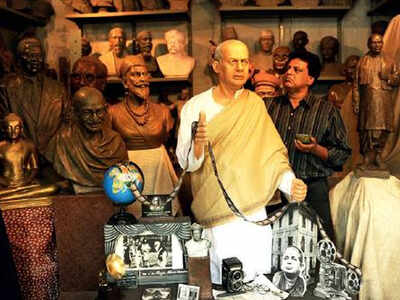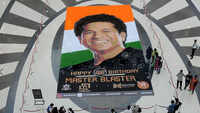
MUMBAI: It is ironical that a nation of 1.25 billion, which acknowledges its debt to filmmaker Dadasaheb Phalke, the father of Indian cinema, scarcely knows what he looked like. The thespian’s descendants and fans have made an attempt to correct this anomaly by creating a lifelike statue of Phalke, with European white skin and green grey eyes, ahead of his 150th birth anniversary.
Dhundiraj Govind Bhat or Dadasaheb Phalke was born on April 30, 1870. His sesquicentennial celebrations are set to begin later this month.
“Two idols of Phalke are visible in Mumbai, one near Hindmata, which was unveiled during his birth centenary in 1970 by Prithviraj Kapoor, and the other in FilmCity, Goregaon, that was placed in 2003,” said Phalke’s grandson Chandrashekhar Pusalkar, who bears a striking resemblance to his ancestor and modelled for Wagh. “My mother Vrunda, who was his younger daughter, would remark at his white skin tone and green grey eyes. When I asked her if my grandfather was fair, she would reply ‘fair like a European’. So I suggested that Wagh bring an element of redness in the cheeks.” These traits of appearance are characteristic of his native Chitpavan Brahmin community.
Phalke passed away in Nashik in February 16, 1944.
Making sense of 2019 #ElectionswithtimesView Full Coverage
Dhundiraj Govind Bhat or Dadasaheb Phalke was born on April 30, 1870. His sesquicentennial celebrations are set to begin later this month.
Third-generation sculptor Vinay Wagh, whose studio is along Chowpatty seafront, has crafted a 4ft torso of Phalke from marine ultraviolet material. He said, “The idol has a close resemblance to the waxworks installed at Madame Tussaud’s museum but it is more sturdy and resistant to heat, water and corrosion. Alongside, we have placed models of his wife Saraswati, his Williamsons camera, projector, gramophone, the film ‘Raja Harishchandra’ and Haud bungalow in Nashik, which was his studio.” Wagh, who also manages the Dadasaheb Phalke International Awareness Mission, said the statue will be used for functions in his sesquicentennial year.
“Two idols of Phalke are visible in Mumbai, one near Hindmata, which was unveiled during his birth centenary in 1970 by Prithviraj Kapoor, and the other in FilmCity, Goregaon, that was placed in 2003,” said Phalke’s grandson Chandrashekhar Pusalkar, who bears a striking resemblance to his ancestor and modelled for Wagh. “My mother Vrunda, who was his younger daughter, would remark at his white skin tone and green grey eyes. When I asked her if my grandfather was fair, she would reply ‘fair like a European’. So I suggested that Wagh bring an element of redness in the cheeks.” These traits of appearance are characteristic of his native Chitpavan Brahmin community.
Phalke passed away in Nashik in February 16, 1944.
Making sense of 2019 #ElectionswithtimesView Full Coverage
more from times of india cities
Elections 2019

Trending Topics
LATEST VIDEOS
City
 Navi Mumbai: Unique artwork on master blaster Sachin Tendulkar’s 46th birthday at Seawoods Grand Central Mall
Navi Mumbai: Unique artwork on master blaster Sachin Tendulkar’s 46th birthday at Seawoods Grand Central Mall  Delhi: Gautam Gambhir addresses party workers during introductory meet
Delhi: Gautam Gambhir addresses party workers during introductory meet  Lok Sabha elections 2019: BJP fields singer Hans Raj Hans from North-West Delhi
Lok Sabha elections 2019: BJP fields singer Hans Raj Hans from North-West Delhi  Government teachers in Delhi fail to utilise tablets for official work
Government teachers in Delhi fail to utilise tablets for official work
More from TOI
Navbharat Times
Featured Today in Travel
Quick Links
Lok Sabha Election Schedule 2019Lok Sabha Election NewsDelhi Capitals teamMI team 2019Rajasthan Royals 2019RCB team 2019Maharashtra Lok Sabha ConstituenciesBJP Candidate ListBJP List 2019 TamilnaduShiv Sena List 2019AP BJP List 2019Mamata BanerjeeBJP List 2019 MaharashtraPriyanka GandhiBJP List 2019 KarnatakaAMMK Candidate List 2019BJP List 2019 WBLok Sabha Elections in Tamil NaduBSP List 2019 UPNews in TamilLok Sabha Poll 2019Satta Matka 2018PM ModiMahagathbandhanNagpur BJP Candidate ListChandrababu NaiduTamil Nadu ElectionsUrmila MatondkarNews in TeluguMadras High CourtTejashwi YadavArvind KejriwalTejasvi SuryaPawan KalyanArvind KejriwalYogi AdityanathJaya PradaSatta King 2019Srinagar encounter
Get the app




